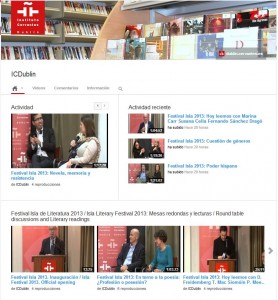Blog del Instituto Cervantes de Dublín
Torre Martello
Los irlandeses y el Camino de Santiago | The Irish and the Way of St. James
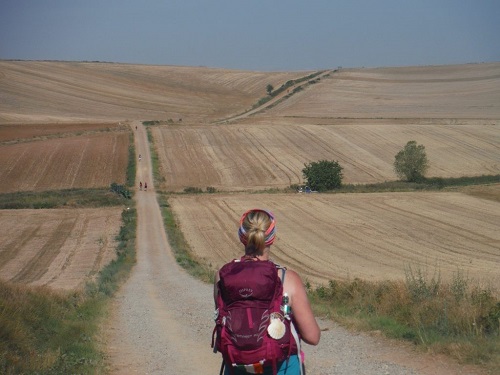
Hoy en día, el Camino de Santiago es conocido como una de las rutas más populares de toda Europa, que atrae cada año a miles de peregrinos y turistas. Tras la consagración de los restos de Santiago en el año 813 d. C. por el obispo de Iria-Flavia y el crecimiento de la peregrinación bajo los reyes de León y de Castilla a lo largo de la Alta Edad Media, el Camino se convertiría en la tercera ruta peregrina más importante del mundo. No obstante, lo que quizás no conocemos bien en Irlanda es la historia de los peregrinos irlandeses y la importancia de la práctica de ir en peregrinación dentro del contexto europeo de la Edad Media.
(Siga leyendo esta entrada…)
Paul Gaffney makes the path by walking | Paul Gaffney hace camino al andar
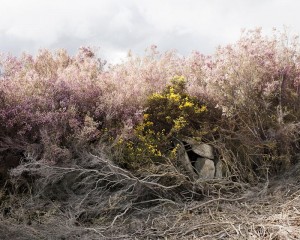 As every year, PhotoIreland and Instituto Cervantes bring you a new exhibition. This time you can enjoy We make the path by walking by artist Paul Gaffney. You can visit the exhibition from July 10th to July 30th. The opening hours are : Mon- Thur 12 am-7pm and Fri 10am-2pm.
As every year, PhotoIreland and Instituto Cervantes bring you a new exhibition. This time you can enjoy We make the path by walking by artist Paul Gaffney. You can visit the exhibition from July 10th to July 30th. The opening hours are : Mon- Thur 12 am-7pm and Fri 10am-2pm.
Over the past year Paul Gaffney has walked over 3,500 kilometres throughout Spain, Portugal and the south of France, with the aim of creating a body of work which explores the idea of walking as a form of meditation. His intention has been to create a series of quiet, meditative images, which would evoke the experience of being immersed in nature and capture the essence of the journey. The images seek to engage the viewer in this walk, and to communicate a sense of the subtle internal and psychological changes which one may undergo while negotiating the landscape.
Paul Gaffney is a Dublin-based artist who has recently completed an MFA in Photography at the University of Ulster in Belfast. His project ‘We Make the Path by Walking’ has been shortlisted for the European Publishers Award for Photography 2013, and also won the Johnsons-Photopia prize at this year’s Format Festival in Derby, England. His work has been exhibited in numerous locations throughout Ireland and the UK, including the Gallery of Photography, Cambridge University, Host Gallery (London) and Third Floor Gallery (Cardiff).
Como todos los años, PhotoIreland y el Instituto Cervantes te traen una nueva exposición. Esta vez puedes disfrutar de Se hace camino al andar del artista Paul Gaffney. La exposición tendrá lugar entre el 10 y el 30 de julio y las horas de visita son lunes a jueves de 12:00 a 19:00 y los viernes de 10:00 a 14:00.
Durante el último año Paul Gaffney ha recorrido más de 3.500 km por España, Portugal y el sur de Francia con el propósito de captar imágenes y momentos que exploren la noción de caminar como vía de meditación. Su intención ha sido crear una serie de imágenes serenas y meditativas que evoquen la experiencia de sentirse inmerso en el entorno y que capturen la esencia del viaje. Las imágenes pretenden hacer partícipe al espectador de este recorrido y reflejar los posibles y sutiles cambios, íntimos y psicológicos, que se viven al atravesar los parajes naturales que le rodean.
Paul Gaffney es un artista afincado en Dublín que ha terminado recientemente un Máster en Bellas Artes en fotografía de la Universidad de Úlster, Belfast. Su proyecto We Make the Path by Walking (Se hace camino al andar) ha sido nominado para el premio EPAP 2013 (European Publishers Award for Photography), y ha sido galardonado con el premio Johnsons-Photopia del Festival Format de Derby, Inglaterra, de este año. Su trabajo se ha expuesto en numerosas localidades de Irlanda y Reino Unido, incluidas la Gallery of Photography, (Universidad de Cambridge), la Host Gallery (Londres) y la Third Floor Gallery (Cardiff).
Seminar and tasting: Rias Baixas | Seminario y cata de vino: Rias Baixas
ONLY A FEW SPACES LEFT!!!
Have you heard about the delicious wines from Rias Baixas? This Thursday at 6.30 pm you have the chance to enjoy a 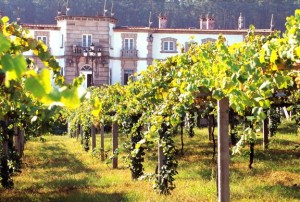 workshop in English where you will learn more about the most renowned wines from Galicia and you will also taste six samples of wines from Rías Baixas. This activity is part of the Celtic Extravaganza: Galicia and El Camino Festival.
workshop in English where you will learn more about the most renowned wines from Galicia and you will also taste six samples of wines from Rías Baixas. This activity is part of the Celtic Extravaganza: Galicia and El Camino Festival.
The fee for this workshop is €15. You can come to our office to register or you can do it on-line if you follow this link:
https://clicdublin.cervantes.es/en/activities
Lisa O’ Doherty is an award winning sommelier with over 10 years experience as chief sommelier at the famous Irish 5 red star resort “The K Club”, home of the 2006 Ryder Cup.
The renowned sommelier Lisa O’Doherty will share her last trip to Rías Baixas and love for this Celtic area in Spain. She will introduce us to one of the most trendy wines in US and its core grape: albariño. 6 Rias Baixas wines will be tasted in this 90 minutes seminar.
The Designation of Origin Rías Baixas (pronounced ree-ahs buy-shuss) is the cool coastal home of the Albariño grape, located in the Celtic region of Galicia and produces some of Spain’s finest white wines.
¡¡¡ÚLTIMAS PLAZAS DISPONIBLES!!!
¿Conoces los deliciosos vinos de las Rias Baixas? Este jueves a las 18:30 tienes la oportunidad de disfrutar de un taller en inglés en el que además de aprender sobre los vinos más reconocidos de Galicia podrás también saborear seis vinos de Rias Baixas.
La actividad está dentro del festival La experiencia celta: Galicia y el Camino de Santiago.
El precio de la entrada del taller es de €15. Puedes venir a nuestra oficina directamente o matricularte desde casa a través del siguiente enlace:
https://clicdublin.cervantes.es/en/activities
La Denominación de Origen Rias Baixas es la franja costera y fría donde se cultiva la uva Albariño. Se sitúa en la región celta de Galicia y produce algunos de los mejores blancos de España.
La reconocida sommelier Lisa O’Doherty compartirá con el público su último viaje a las Rias Baixas y su amor por esta región celta de España. Dará a conocer uno de los vinos más de moda en EEUU y su cepa principal: Albariño. En este seminario de 60 minutos de duración se degustarán 6 vinos de Rias Baixas.
Lisa O’Doherty ha recibido numerosos premios durante sus 10 años de experiencia como sommelier jefe del famoso complejo turístico irlándés de 5 estrellas, The K Club, sede de la Ryder Cup 2006.
The Way of Saint James / El Camino de Santiago
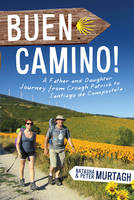
Nuestro tema del mes es el Camino de Santiago, una de las principales rutas culturales europeas. Cada año miles de peregrinos procedentes de toda España y Europa recorren un largo trecho para llegar a la ciudad de Santiago de Compostela, donde se veneran las reliquias del apóstol Santiago el Mayor. La creencia cada vez más extendida en los milagros de Santiago, provocó que la gente comenzara a peregrinar hacia Santiago de Compostela para obtener su gracia.
El Camino de Santiago significó el primer elemento vertebrador del viejo continente en la historia europea y supuso encontrar un punto de referencia indiscutible en el que podía converger la pluralidad de distintos pueblos ya cristianizados pero necesitados en aquel entonces de unidad.
Ha estado unido indisociablemente a la cultura, a la formación y a la información. Lo que se decía, predicaba, contaba, cantaba, esculpía o pintaba en el camino alcanzaba siempre a más gente y a más lugares. Gracias a su influjo en el arte y la literatura, Compostela junto con Jerusalén y Roma se convirtió en meta de la sociedad cristiana, especialmente a partir del siglo XI al XIV. El camino llegaría a ser un foco catalizador de toda la sociedad cristiana.
Durante toda la Edad Media fue muy popular, después fue ligeramente olvidado debido a diversos factores (la peste, la reforma protestante y los conflictos políticos). En la época actual ha vuelto a tomar un gran auge. El Camino de Santiago Francés y las rutas francesas del Camino fueron declarados por la Unesco Patrimonio de la Humanidad en 1993 y 1998 respectivamente, Itinerario Cultural Europeo por el Consejo de Europa y ha recibido el título honorífico de Calle mayor de Europa. En el Año Santo Compostelano de 1993, el gobierno autónomo gallego decidió potenciar su valor enfocado a un recurso turístico, de este modo se lanzó una gran campaña de publicidad para el Jacobeo de ese año: Xacobeo 93. Gracias a este plan se restauraron tramos de la ruta y las infraestructuras para peregrinos.
Desde entonces, hacer el recorrido a pie, en bicicleta o a caballo e incluso en burro es un destino popular que reúne lo religioso, espiritual, deportivo, cultural, económico, etc., tal y como ha venido ocurriendo desde el principio a través de los siglos. El camino se halla indicado por flechas pintadas de amarillo, postes y otras señales. La mayoría de los peregrinos llega a Santiago por el llamado “Camino Francés”, pero existen otras seis rutas históricas por las cuales se puede hacer el camino santo.
Si quieres preparar tu viaje de peregrinación a Santiago o simplemente saber más sobre el Camino, en la biblioteca tenemos una amplia selección de obras que te pueden ayudar.
Our topic of the month is the Camino de Santiago (The Way of St James), one of the most important European cultural routes. Every year thousands of pilgrims coming from all parts of Spain and Europe go a long distance until arriving to Santiago de Compostela where the remains of the apostle Saint James are venerated. It started when people started to believe in St James’ miracles and therefore they started to do the pilgrimage to Santiago to get his grace.
Camino de Santiago was the first backbone of the old continent in the European history and an indisputable reference point where the different conceptions of Christian peoples could find a common unity.
It has been linked inherently to culture, education and information. Everything that was said, preached, told, sung, sculpted or painted in the Camino got to a large number of people and places. Thanks to its influence in art and literature, Compostela along with Jerusalem and Rome became a meeting point of Christian society, especially between the 11th and 14th century.
It was highly travelled during the Middle ages but several factors (the Black Death, the Protestant Reformation and political unrest) led to its decline. By the 1980s, only a few pilgrims per year arrived in Santiago. Later, the route attracted a growing number of modern-day pilgrims from around the globe. The route was declared the first European Cultural Route by the Council of Europe in October 1987; it was also named one of UNESCO’s World Heritage Sites in 1993.
In 1993, a Jubilee Year, the Galician government decided to increase its popularity and planned a big advertising campaign to promote the Camino and the infrastructures were highly improved.
Today tens of thousands of Christian pilgrims and many other travellers set out each year from their front doorstep, or popular starting points across Europe, to make their way to Santiago de Compostela. Most travel by foot, some by bicycle, and a few travel as some of their medieval counterparts did, on horseback or by donkey.
In addition to people undertaking a religious pilgrimage, the majority are travellers and hikers who walk the route for non-religious reasons: travel, sport, or simply the challenge of weeks of walking in a foreign land. Also, many consider the experience a spiritual adventure to remove themselves from the bustle of modern life. It serves as a retreat for many modern “pilgrims”.
Most of the pilgrims arrive to Santiago by taking the French Way but there are other six historical routes to do the Camino.
If you want to prepare your pilgrimage route to Santiago or simply to know more about the Camino, in the library we have an ample selection of works that can help you.
Las sombras del peregrino en la obra de Joyce / Pligrim shadows in Joyce’s work
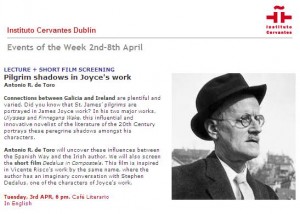
Lamentamos comunicarles que la actividad “Sombras peregrinas en la obra de James Joyce”, prevista para hoy 3 de abril a las 18h en el Café Literario ha sido cancelada.
Rogamos disculpen las molestias.
We are sorry to inform you that the Lecture + Film Screening “Pilgrim shadows in Joyce work”, scheduled to take place today April 3rd at 6pm at Café Literario, has been canceled.
We apologize for any inconvenience caused.
Las conexiones entre Galicia e Irlanda son abundantes y variadas. ¿Sabías que los peregrinos de Santiago son retratados en la obra de James Joyce?
En sus dos obras principales, Ulises y Finnegans Wake, el novelista más influyente e innovador de la literatura del siglo XX dibujó las sombras de los peregrinos entre sus personajes.
Antonio R. de Toro se detendrá en su conferencia a analizar las influencias entre el Camino de Santiago y el autor irlandés.
Durante la velada, se proyectará también el cortometraje Dedalus en Compostela. Esta película está inspirada en la obra de Vicente Risco con el mismo nombre, donde el autor tiene una conversación imaginaria con Stephen Dedalus, uno de los personajes de la obra de Joyce.
Conferencia + proyección de cortometraje.
Martes, 03 de abril, 6 pm. Café Literario
En Inglés
Connections between Galicia and Ireland are plentiful and varied. Did you know that St. James’ pilgrims are portrayed in James Joyce work?
In his two major works, Ulysses and Finnegans Wake, this influential and innovative novelist of the literature of the 20th Century portrays these peregrine shadows amongst his characters.
Antonio R. de Toro will uncover these influences between the Spanish Way and the Irish author.
We will also screen the short film Dedalus in Compostela. This film is inspired in Vicente Risco’s work by the same name, where the author has an imaginary conversation with Stephen Dedalus, one of the characters of Joyce’s work.
Lecture + Short film Screening.
Tuesday, 3rd APR, 6 pm. Café Literario
In English



